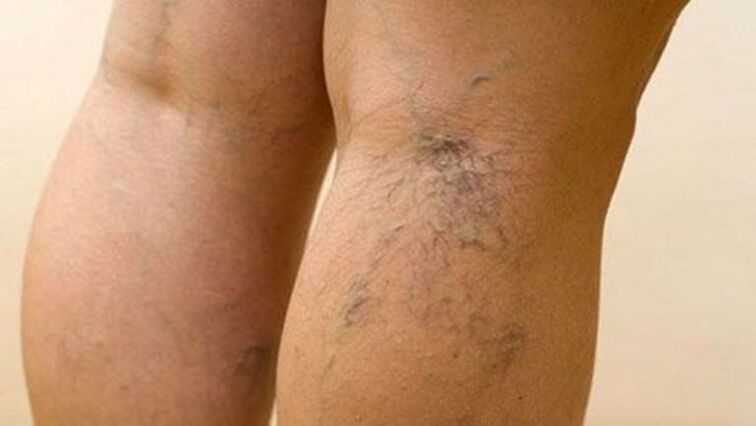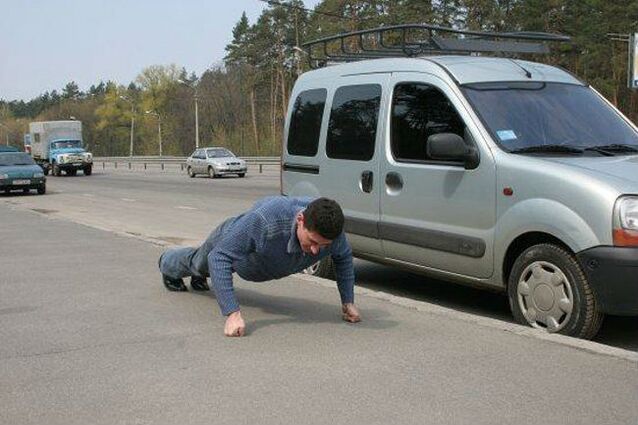
According to information provided by medical institutions, varicose veins of the lower extremities are found in every fifth man and 28% of women of working age.
When looking at the entire population, half of adults have characteristic symptoms.
The peculiarity of this disease is growth from comfortable living conditions. Studies in Asian countries have shown a lower prevalence among the poor who do manual labor and take long walks.
Why are the veins of the legs strained?
The anatomical structure of the vein wall is characterized by a reinforced muscular skeleton and a valve apparatus. The convenience resides in the need not only to maintain the flow of blood in a person's vertical position, but also to organize its ascent against gravity towards the heart.
The valves block the return flow to prevent overfilling in the most distant parts of the housing. That "uncomfortable" place is the legs and feet.
The mechanism of the formation of varicose veins of the legs
At the age of 40, the human body begins to synthesize limited plastic materials, the main of which is collagen protein. It is essential for good venous valve tone. The absence leads to loss of tone, sagging, and the inability to delay the return of blood and the mass above it.
The network of veins in the legs is made up of superficial vessels that lie just below the skin and deep veins that are in the thickness of the muscle layer.
Varicose veins of the lower extremities are characterized by an initial lesion of the valves of the superficial veins. The congestion manifests itself in areas with dilated fine veins that are visible to the eye in the form of a fine network.
The further development of the pathology leads to blood deposition in the periphery and causes tissue edema (fluid leakage through the vein walls), malnutrition (the outflow of toxins is reduced, oxygen and nutrients are retained by compressed arteries).
How complications combine
The stagnation of venous blood in the legs leads to slowed blood flow in the vessels, which creates favorable conditions for the aggregation (adhesion) of platelets. Blood clots complicate an already impaired blood supply.
The risk of an embolic rupture and its movement through large vessels to the heart increases. If a person has defects associated with right and left ventricular communication, it is possible for an embolus to get into the arterial blood and necrotic changes to develop in the organs.
The most common accompanying complication is the addition of a local infection in the affected area of the venous wall, followed by the development of phlebitis or thrombophlebitis.
Causes of the disease
There is only one reason for varicose veins of the lower extremities, regardless of the person - a genetic deficiency in the collagen structure. It manifests itself not only in varicose veins, but also in relatively early signs of aging (dryness, deep wrinkles).
Other reasons are related to people's activities and behavior.
- Reduced physical activity or, conversely, heavy physical work leads to a violation of the tone of the leg veins.
- Forced standing or sitting during working hours leads to blood congestion in the legs and impaired drainage.
- Pregnancy puts increased pressure on the pelvic organs and large veins, which prevents drainage from the lower veins.
- Doctors from Asian countries associate the growth of varicose veins on the legs in patients with an addiction to the European habit of sitting in a chair or stool instead of bending the knees.
- Comfortable high toilets require increased tension in the abdominal wall muscles when defecating, overexertion contributes to stagnation in the legs. When squatting, bowel movements are more physiological.
- The habit of fast food, reducing the amount of raw vegetables and fruits in the diet leads to constipation and prolonged stress.
- Smokers expose the whole body to the effects of nicotine, which acts like a crippling poison on the veins.
- Fashionable high-heeled footwear leads to improper strain on the leg muscles and disrupts the tone of the veins.
- Common pills, hormonal contraceptives, treatment with hormonal drugs for menopause, osteoporosis lead to impaired collagen synthesis.
- The advertised slimming underwear and wearing tight jeans cause the blood to stagnate in the parts of the body below.
Who should be included in the risk group?
Given the listed reasons for the development of venous pathology, the group of people with an increased likelihood of developing varicose veins of the legs should include:
- People who are professionally associated with prolonged standing or sitting (salespeople, teachers, hairdressers, drivers, office workers);
- Women who prefer skinny jeans, shaping underwear and high heels;
- People who practice weight lifting and bodybuilding;
- People who are used to sitting "next to each other";
- Women with frequent pregnancies and childbirths and taking hormonal contraceptives;
- Smokers, lovers of strong coffee and alcohol;
- clogged.
Preventive measures are required for these populations.
Symptoms
The first symptoms of varicose veins in the legs are noticeable at a young age. In the initial stage, they occur with increased load on the legs:
- at the end of the shift there is pain in the feet and legs, muscle fatigue;
- when changing shoes, there is swelling of the feet due to the tightness of the shoes;
- in the evening the feet "burn", one would like to dip them in cold water;
- "Spiders" form on the skin of the thighs and legs.

At the next stage, a picture of chronic venous insufficiency develops, symptoms of internal varicose veins appear:
- disturbed by nocturnal calf cramps, cramps possible when walking;
- dark spots, dryness, peeling appear on the skin of the feet and legs;
- the appearance of trophic ulcers, very painful, with loose edges, difficult to treat.
If against the background of local pain, swelling, redness of the skin and an increase in body temperature, then you need to think about thrombophlebitis.
diagnosis
In diagnostics, it is customary to differentiate between true (primary) varicose veins, depending on the lesion of the valve apparatus, and secondary ones, as a result of trauma and tumors.
Surgeons from polyclinics, vascular surgeons, phlebologists are involved in the examination. The doctor sees subcutaneous venous nodes, vascular networks, skin pigmentation, incipient ulcers, dermatitis.
During palpation, the tension of the superficial veins, the density of the wall, the size of local changes, the presence of a thrombus, the temperature of the skin over the node (signs of thrombophlebitis) are assessed.
A general blood test shows the onset of inflammation (leukocytosis, accelerated ESR), a tendency to thrombus formation according to the coagulogram.
Vascular ultrasound allows you to track blood flow, the function of the venous valves, and detect blood clots.
Doppler examination allows you to check the structure of the veins in order to make a diagnosis in the early stages of the disease.
In the event of diagnostic difficulties, the spiral computed tomography method is carried out. It enables a three-dimensional image of the anatomical area and helps in the choice of surgical treatment.
Treatment of varicose veins of the legs
It is better to start the treatment of varicose veins of the legs at the initial stage. To do this, you need to think about the necessary changes in habits, diet and exercise.
mode
In order not to swell their legs at the end of the working day, people in "sitting" and "standing professions" are recommended to take physical culture breaks or warm-up exercises with foot massage in an elevated position. Drivers and office workers should run around during breaks.
The simplest exercises can be done at work:
- stand barefoot on the floor alternately on toes and heels;
- Sit in a chair, lift your legs up and make circles with your feet in one direction, then the other.
Morning exercises should include exercises in the lying position: alternate leg raises, "bikes", shaking raised legs. Exercises with squats, bent knees are not suitable.
Lovers of strength training should refuse them. Swimming, cycling and walking are shown the most.
Choosing a balanced diet
Limit all foods that add weight, promote fluid retention, and increase blood viscosity.
Fatty meat and dairy products, spicy and salty foods, canned goods, sweets, baked goods, carbonated drinks are not recommended.
In the daily diet, you should use more vegetables and fruits, berries, onions, garlic, fermented dairy products, cereals, vegetable oils instead of butter and walnuts.
Vein support methods
Wearing compression stockings or golf is recommended to support blood circulation. They are sized so that they can be worn lying on your back.
As a remedy, silicone-filled treads are touted, which generate an electrical charge on the surface of the foot.
Specialists pay attention to the possible effects of these aids only in the initial stages of the disease. With superficial lumps and edema on the legs, their use is completely useless.
Taking medication
The drug treatment consists in the oral intake of drugs from the group of "venotonics" in a therapeutic dose selected by the doctor. They help relieve tiredness and discomfort in the feet, but they don't get rid of the disease.

Surgeons attribute varicose vein medication to background conservative treatment, but the most important one is one of the less traumatic ways of affecting the affected veins. The effectiveness is confirmed in 95% of the patients. More severe interventions are only used in 5% of patients.
What about minor trauma operations
With low-trauma methods of treating varicose veins, you can avoid surgery and rightly come first in terms of effectiveness. They do not require an incision, can be done in a polyclinic, and are practically painless. The patient is not restricted in terms of work and movement. A long recovery period is not required after the operation.
Laser ablation method
It is done under local anesthesia. A light guide is inserted into the varicose vein and a circular laser beam is turned on while moving backwards.
Effect of the method: The jet causes a pronounced burn of the inner lining of the vein, which hardens further. The duration of the intervention is about two hours. The method is applicable to the treatment of veins of any size.
Sclerotherapy technique
A substance is injected into the affected vein that can cause the walls to collapse and scarring. Foam preparations that fill the lumen of the diseased vein quickly and safely are particularly recommended. The method is applicable if the diameter of the vessel is up to 1 cm. After the introduction, it is necessary to walk for an hour. Phlebologists recommend wearing compression stockings for another month.
Method of microflebectomy
A skin incision several mm long is made under local anesthesia, through which a diseased vein is grasped with a hook, brought to the surface of the skin and cut out. The procedure is suitable for venous nodules of any size and diameter. A small scar remains at the incision site. You must wear compression stockings or stockings for 10 days.
Radiofrequency ablation method
It is performed in a similar way to laser, but differs in the effect of microwave radio frequencies. This method does not cause tissue burns and is therefore less traumatic than the laser. After 30 minutes of exposure to microwaves, the lumen of the vessel is closed. After 7 days, the rehabilitation is considered complete. You can do sports.
In which cases is the operation indicated?
In the event of unsuccessful treatment with conservative methods and the impossibility of using minimally invasive techniques, a phlebectomy operation is prescribed. It allows you to remove large areas of varicose veins and bundles.
The patient is admitted to the hospital. Surgical treatment is performed under general anesthesia. Two cuts are usually made: in the groin area and below the knee. The vein is tied off on both sides, pulled outwards and removed. Sutures are attached to the cuts. The patient is treated in a hospital for a week. Medicines are used that reduce blood clotting. The sutures are removed after at least 7 days.
A phlebectomy is not done:
- the age of the patient;
- with massive damage to deep and superficial veins;
- during pregnancy;
- with arteriosclerosis of the vessels of the legs, diabetes mellitus;
- if there are skin diseases at the site of the planned operation.

Prevention methods
Prevention of varicose veins of the legs is primarily necessary for people with risk factors at work.
More walking is recommended. There is a massage and strengthening of the vein walls.
During the breaks, salespeople and hairdressers are shown foot and shin massages. It is done with slow, gentle movements in the direction from the fingers to the knee and along the thigh. The knuckles of the fist are massaged in a circular motion towards the central fossa of the foot.
Drivers have to get out of the car, walk around, stretch their legs. Exercises for the legs are shown.
Fashionistas should think about the consequences before putting on high heels and wearing tight clothes.
At home, you can do contrast baths or foot showers. Apply a compress on tired legs with decoctions of chamomile, chestnut, wormwood and burdock.
Timely visit to the surgeon will allow you to get rid of painful problems, restore activity and movement.




































